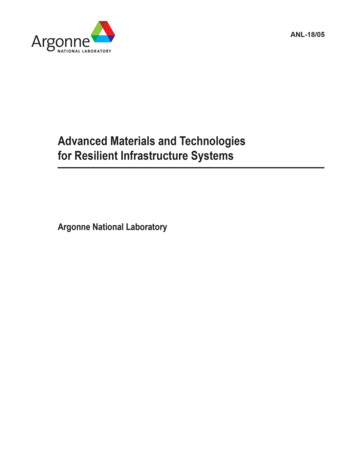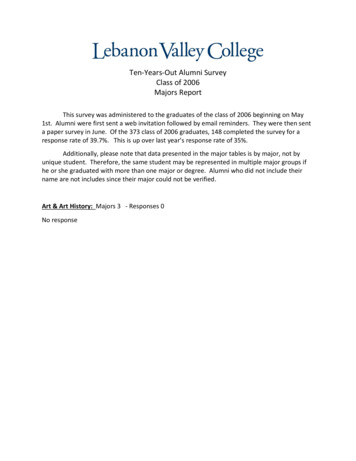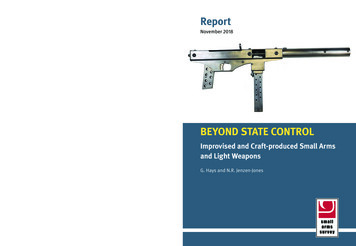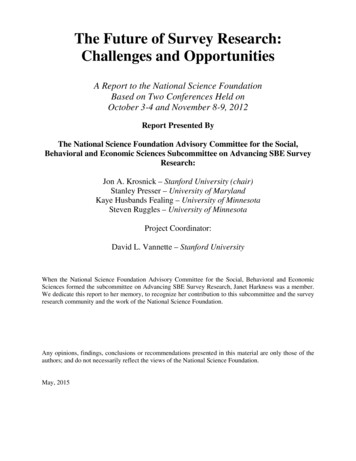
Transcription
CONTENTSFOREWORD .1OVERVIEW .11SECTOR-SPECIFIC CHALLENGES AND OPPORTUNITIES .31.1 Materials and Technologies for the Energy Sector .1.2 Sensors and Treatment Systems for the Water and Wastewater Sector .1.3 Structural Materials for Transportation and Nuclear Sectors .3672DISCUSSION .103ACKNOWLEDGMENTS .124REFERENCES .13FIGURES12Extreme Weather Events Resulting in Damages in Excess of 1 Billion. For 2017,the Number of Events Shown is as of October 6, 2017. .2Left: Weather and Physical Attack Led to the Greatest Number of Electric PowerDisruption Events between 2011 and 2014. Right: Major Outages Resulting in theLoss of Electric Service to More Than 50,000 Customers for 1 Hour or More. .3TABLE1R&D at Argonne for Resilient Infrastructure Materials, Components, and Systems .iii11
This page intentionally left blank.iv
ADVANCED MATERIALS AND TECHNOLOGIES FOR RESILIENTINFRASTRUCTURE SYSTEMSH. Kim, M.C. Clifford, S.B. Darling, S.W. Snyder, M. Kaminski, C. Chen, A. V. Sumant,A. Heifetz, K. Hardy, M. Biruduganti, and C.M. MacalFOREWORDThis report is a survey of the capabilities at Argonne National Laboratory that can enablebridging the gap between discovery science and applications to enhance resilience across variouscritical infrastructures, including energy, transportation, water, and nuclear.OVERVIEWInfrastructure is largely unnoticed until it breaks down and services fail. This includeswater supplies, gas pipelines, bridges and highways, phone lines and cell towers, and the electricgrid — all of the complex systems that keep our societies and economies running. The secureand reliable functioning of our nation’s critical infrastructure is required; however, U.S.infrastructures face a rising frequency and severity of natural disasters (Figure 1), and a growingnumber and sophistication of physical and cyber attacks. With increasing technological andeconomic progress, infrastructures are growing more interconnected, necessitating newconsiderations for their security. Recent disasters such as Superstorm Sandy provide profoundinsights into how non-linear interactions combine with network effects to trigger a cascade ofevents across interdependent systems. Compounding these risks is the degrading condition ofinfrastructure assets, which interacts in subtle ways with environmental stressors to magnify theimpact of disasters (U.S. Department of Homeland Security [DHS] 2010). 1Meeting these challenges requires communities to strengthen existing infrastructure andbuild new systems based on modern designs, technologies, and methods that account for growingdemand in an increasingly urbanized and connected world. While progress will depend onmultiple policy and market drivers, scientific innovation will provide the necessary knowledge,technologies, and enabling materials. As a U.S. Department of Energy (DOE) national lab,Argonne National Laboratory is well positioned to leverage its world-class facilities andexpertise in fields ranging from nano-scale materials to large-scale manufacturing to driveintegrated research, development, and deployment (RD&D) for resilient infrastructure systems.1 In its quadrennial assessment, the American Society of Civil Engineers (ASCE) rated the current condition ofour nation’s infrastructures with an overall grade of D . Grades were assigned according to eight criteria,including capacity, condition, public safety, and resilience. The ASCE estimates that 4.6 trillion is needed by2025 to bring U.S. infrastructure to acceptable standards (ASCE 2017).1
FIGURE 1 Extreme Weather Events Resulting in Damagesin Excess of 1 Billion. For 2017, the Number of EventsShown is as of October 6, 2017. (Source: National Oceanicand Atmospheric Administration 2018)In 2015, Argonne established the Resilient Infrastructure Initiative (RII) to focus RD&Dto assess and address critical systems resilience (Clifford 2016). As a first priority, RII efforts arefocusing on developing models and high-fidelity methodologies to capture interdependenciesacross the lifeline sectors. 2 To date, the RII team has built integrated systems models to identifycritical nodes and downstream dependencies for electric power and natural gas. While thesemodels were developed primarily as tools for planners, operators, and responders, they can alsobe used to inform development in technologies and materials for resilience. Argonne researcherscan integrate new component designs into systems-wide models to deliver insights on the valueadded of emerging technologies to systems-level properties, such as risk, vulnerabilities, andperformance measures. Argonne envisions a joint, coordinated effort that integrates riskassessment models with technology development.In the longer term, RII is integrating expertise across the laboratory to drive research intechnologies and advanced materials to address critical infrastructure needs. This paperhighlights some of the research and development (R&D) challenges for infrastructure sectors andthe intersection with Argonne’s capabilities in technologies and advanced materials.2 Lifeline sectors include Energy, Water, Transportation, and Communications.2
1 SECTOR-SPECIFIC CHALLENGES AND OPPORTUNITIES1.1 MATERIALS AND TECHNOLOGIES FOR THE ENERGY SECTORThe Energy Sector is overseen by DOE at the federal level and consists of threeinterrelated segments: electric power generation and transmission, residential and industrialenergy use, and transportation fuels. Primary energy sources for all segments include oil, naturalgas, nuclear fuel, renewables, and coal. Mitigating energy disruptions is particularly importantbecause other critical infrastructures rely on energy services to operate. Transmission, storage,and distribution (TS&D) assets for electricity are most vulnerable to natural phenomena, withweather being the leading cause of disruptions since 2005 (Figure 2). DOE has placed a highimperative on protecting the electric power grid from weather and high-intensity, low-frequency(HILF) events, such as coordinated attacks and severe geomagnetic disturbances (DOE 2015).Today’s electric power grid is evolving in technological and operational complexity toward anagile and modernized grid of the future, and utilities and agencies are expressing renewedinterest in technologies, control systems, and critical infrastructure protection standards.FIGURE 2 Left: Weather and Physical Attack Led to the Greatest Numberof Electric Power Disruption Events between 2011 and 2014. Right: MajorOutages Resulting in the Loss of Electric Service to More Than 50,000Customers for 1 Hour or More. (The leading cause of major outages isweather, followed by equipment failure.)Argonne leads a broad portfolio of distributed generation solutions for providing loadrelief in congested grid locations, maintaining emergency power to critical services andinfrastructures, and improving visibility and agility for operators during an event (Wang et al2014; Argonne National Laboratory undated). While emerging smart grid technologies have thepotential for improving grid resilience, incorporating these devices for enhanced systemrestoration in response to severe events is a complex and challenging task. Integrated solutionsare needed to aid utilities in developing comprehensive, agile, and adequate strategies forrestoration. Because traditional restoration strategies face many challenges for outages underextreme weather events, system-level resilience requires multiple approaches to obtain solutions.3
These approaches include data analytics and distribution automation techniques to improve thesituational awareness after disasters; advanced optimization techniques to improve the crew andresource allocation and dispatch; and advanced control methods to enable supply continuityutilizing distributed energy resources. To address these needs, Argonne is developing integrateddecision support tools for distribution system restoration that will assist electric utilities inimproving system restoration under extreme events. Multiple sources of information areintegrated to enhance situational awareness regarding the damage after the event, and crew andresource dispatch can be conducted efficiently by using advanced optimization techniques (Chenet al. 2016).Argonne’s extensive work in grid technologies also includes the DOE Electric VehicleSmart Grid Interoperability Center (ANL-IOC), which focuses on developing technology andstandards for vehicle-grid connectivity, communication, and interoperability. It also facilitatesglobal harmonization of interoperability requirements and standards. The scope has expandedbeyond vehicles to include integration with distributed energy resources and building systems,and applying Argonne-developed metering, communication, and integrated control technologiesto other grid-connected devices and local grids. One of the main thrust areas for ANL-IOC is thedevelopment and verification of enabling technologies for grid connectivity and communication,including sub-meters, communication controllers, smart charge adapters, and diagnostic andcompliance tools. Using the Argonne Smart Energy Plaza’s microgrid, ANL-IOC focuses ontesting metering, communication, and integrated control technologies in a flexible network ofgrid-connected devices. The center also develops open source solutions for grid integration, forexample, by using protocol ‘translators’ and an Internet of Things approach to harmonizecommunication among vehicles, buildings, distributed energy resources, and storage.At the system level, shifting from a centralized to a more distributed generation paradigmwill improve grid resiliency by enhancing self-sufficiency, reliability, and redundancy of design.Argonne’s Distributed Energy Research Center (DERC) offers many capabilities, such asadditive manufacturing for distributed generation, combined heat and power (CHP) systems, andinternal combustion engines. Some of the technologies pursued at DERC include novel ignitionsystems, air pretreatment with gas separation membranes, combustion diagnostics, and locallyavailable opportunity fuels with low-energy content. Because fuel is deemed the largestoperational cost for distributed generation, improving engine efficiency through these methodshas great impact for market adoption. To that end, Argonne has developed and demonstratedvarious high-energy ignition systems to improve efficiency in stationary engines whilesimultaneously reducing nitrogen oxide (NOx) emissions using ultra-lean or dilute combustion(Biruduganti et al. 2010). DERC also houses other experimental facilities that enable research inmicro-turbines and small-scale distributed generation, suchas micro-CHP.At the component level, one of the bottlenecks inimproving electric power grid resilience lies at the powergeneration or receiving end, particularly with powerelectronics that handle high voltages and currents.Traditional grid electronics are often based on siliconmaterials, whose properties degrade dramatically at higher4
operating temperatures. Other components, such as transformers, have design features that makethem highly susceptible and difficult to recover from disasters (Electric Power Research Institute2014). Indeed, the primary risk scenarios for the power grid involve events that disabletransformers in multiple generating stations, leading to prolonged outages over wide geographicareas (DOE 2012, 2015).Next-generation solid-state devices based on wide bandgap (WBG) materials will play acrucial role in enhancing electric power grid capabilities, protecting critical assets, and enablingbreakthroughs for resilient transformer design (Energetics Incorporated 2015). While WBGmaterials such as SiC and GaN have been actively researched for these applications, widerbandgap materials like diamond are gaining great interest because of their outstanding electrical,thermal, and mechanical properties. Argonne is developing diamond materials for solid-stateelectronics wherever high frequencies, powers, temperatures, or voltages are required. Recentwork at Argonne has demonstrated the feasibility of integrating diamond with other WBGmaterials such as GaN for efficient heat management. The ability to directly integrate diamondwith GaN through low-temperature diamond deposition processes developed at Argonne (Goyalet al. 2012) represents a game-changing step for solid-state devices, with high impact potentialfor the power industry.At the materials level, the resilience of infrastructure components is often limited tomaterial properties in extreme environments. New developments such as coatings and hybridmaterials offer a pathway toward meeting goals for increased capacity and reliability ofcomponents. Argonne has decades of experience in testing and reliability analysis for industry tounderstand component failure under conditions of overload and corrosion and has engineeredproducts for industry, including carbon films and heat transfer fluids to minimize loss.Argonne is harnessing the unique properties of materials at the nanoscale to control andtailor desired properties. One example is the field of covetics, an emerging science based onnano-carbon infusion into a range of metals. Covetic nanomaterials exhibit significantlyenhanced properties over traditional metals and are currently being explored with industrypartners for high-voltage transmission lines and capacity load relief (Forrest 2016). Otheradvanced materials can provide failure mitigation under extreme thermal, chemical, andtribological stresses (Singh et al. 2016). Examples include graphene-based superlubricity(Berman et al. 2015), first achieved at Argonne, which can increase the reliability of powergeneration turbines, wind turbines, and magnetic disc storage devices, and is currently beingdeveloped with automotive industry partners.TS&D infrastructures for natural gas are generally less vulnerable than electric power,but their recovery is complicated by the need to locate and repair underground breakages. Highrisk components include transmission pipelines, compressor stations, and distribution systems,whose disruption could result in significant outages. Among concerns for natural gas are pipelinebreakage, which occurs from natural disasters, material failure from corrosion and temperature,and breakages propagating from collocated pipelines (DOE 2015). Another concern for naturalgas comes from methane emissions (DOE 2015), most of which arise from underlying leakprone materials. Argonne has developed highly sensitive methane chemoresistive sensorsthrough the use of atomic layer deposition to functionalize multiwalled carbon nanotubes5
(Humayun et al. 2015). As a partner of DOE’s ExtremeMat research consortium, Argonne isdesigning materials for resilience under a wide range of extreme conditions, including for thenatural gas sector. This integrated effort across modeling, validation, and manufacturing willgreatly enhance Argonne’s impact potential for energy and other sectors.1.2 SENSORS AND TREATMENT SYSTEMS FOR THE WATER ANDWASTEWATER SECTORIn the Water and Wastewater (W&W) Sector, the U.S. Environmental Protection Agency(EPA) oversees the protection of drinking water and wastewater systems, 3 whose disruption cancause severe public health and economic consequences. This sector consists of multiplecomponents, including water sources, storage, treatment, and discharge; as well as monitoringsystems and physical distribution networks. A significant risk in the W&W Sector comes fromnatural disasters that impact water quality, quantity, and utilities’ ability to function (DHS andEPA 2015). Other concerns include disruptive cyber events and manmade disasters thatintroduce chemical, biological, radiological, and nuclear (CBRN) contamination. In its 20162019 Strategic Action Plan, the EPA Office of Homeland Security identified three main R&Dobjectives for water systems resilience: (1) detection and response to contamination events anddisruptions, (2) systems assessment of vulnerabilities, and (3) understanding of the implicationsof design decisions on system resilience (EPA 2015). Water and wastewater are typicallyregulated, permitted, and managed at the state level, creating additional challenges toinfrastructure resilience (e.g., see Mihelcic et al. 2017).The development of sensitive detection and mitigation technologies is enabled by theability to control and tailor material properties. Argonne’s existing capabilities are well alignedto meet these needs (Kline-Schoder et al. 2015; Lee et al. 2015). An illustrative example is thedevelopment of functionalized magnetic structures that detect CBRN threats. Argonne pioneeredthe use of magnetic micro-particles for trace separations of radionuclides and developed keyaspects of magnetic micro- and nanoparticle synthesis for biological threat agent isolation anddetection. Such multifunctional magnetic structures are being integrated with sensor platformsand waterborne transport modeling tools. This integrated system combines various modules—sample acquisition, sample processing, trace separations, sample analyses, and command/controland data access—and the entire system is contained within a submersible vehicle with currentdesigns for a long-range autonomous underwater vehicle. This capability enables an integratedapproach to CBRN scenarios through automated target detection, consequence assessment, andforensic analysis via fate/source tracing of contaminants.Beyond municipal water, agricultural groundwater and industrial water are intricatelyintertwined with freshwater quality, food security, and energy production. With nearly one-fifthof the world’s population living in areas of water scarcity, there is a global need for research toidentify decontamination and purification processes that minimize cost and energy use compared3 As defined by DHS, which oversees each sector along with sector-specific agencies. Beyond the W&W Sector,numerous bodies govern water quality, pollution prevention, and offshore incidents. These include the Bureau ofSafety and Environmental Enforcement and the U.S. Coast Guard.6
to currently available methods. Argonne is highly active in developing designer materials forwater purification and pollution remediation, including functionalization of membrane interfacesand catalytic coatings for toxin degradation (Lee et al. 2016; Jaeger et al. 2014). For example,one of the most significant barriers to membrane separation technology for wastewater treatmentis fouling of membrane surfaces. Argonne has developed a self-cleaning photocatalytic nanofiltration membrane by leveraging a biomimetic mineralization process to address the foulingchallenge (Lv et al. 2017).Advances in designer materials have the potential not only to improve performance ofexisting systems, but also to facilitate the development of new classes of technologies. Oneexample is a new class of adsorbent material developed by Argonne for removal of contaminantsat larger scales. A recent breakthrough in the technique of sequential infiltration synthesis hasenabled an innovation, called Oleo sponge, designed to clean up oil spills even from the middleof the water column (Barry et al. 2017). These materials are coordinated to a substrate in aformat that enables adsorbency from the environment and then separation of the contaminationin a roll press. This approach has great potential for adaptation to other contaminants that arepresent in large volumes, including pathogens, radionuclides, and heavy metals. The technology,developed in partnership with the U.S. Coast Guard, could find broad application in response tonatural and manmade disasters.Desalination and related technologies are also of central importance in addressing waterscarcity and other issues at the water-energy nexus. Argonne is driving integrated water-energysolutions that can treat water that is fit-for-purpose, thereby reducing energy demand and cost.A recent innovation is in materials and processes for electrokinetic purification of water. Theseplatforms include resin wafer electrodeionization (RW-EDI) and capacitive deionization (CDI)(Pan et al. 2017). Unlike existing processes that remove the water from the brine, electrokineticmethods remove the salt and other charged species from the water. They are designed for a broadrange of applications beyond seawater, such as brackish groundwater or reclaimed industrialwastewater. By providing alternative sources for water away from the sea coasts, Argonne isincreasing the resilience of the overall water system. As desalination requires energy input,diluting salt into water can generate energy. Argonne is exploring storing the salt concentrate andrunning electrokinetic systems in reverse to provide power to the electric power grid at times ofpeak demand. This process will enable the water treatment plants to contribute to the reliabilityof the grid.1.3 STRUCTURAL MATERIALS FOR TRANSPORTATION ANDNUCLEAR SECTORSThe Transportation Sector, overseen by the U.S. Department of Transportation (DOT),consists of seven subsectors: aviation, maritime, highway, mass transit, freight rail, pipeline, andpostal. Based on the experience and overall research themes at Argonne, the greatest potential forimpact lies in the highway subsector, comprised of bridges, tunnels, and roadways. State andlocal governments own 97 percent of the highway infrastructure and share joint responsibilitieswith federal governments to monitor their needs (American Road and Transportation BuildersAssociation 2018). Risks in this subsector include physical attacks, which can cause significant7
disruptions and long-term economic impairment. Extreme weather events and natural disastershave exacerbated vulnerabilities and are projected to have increased impacts through rising sealevels, storm surges, service disruptions, and materials degradation (U.S. Global ChangeResearch Program 2014; DHS and DOT 2015). Damage at obvious chokepoints like bridges candelay emergency services and the recovery of other sectors during a widespread event. Asofficials consider the future of transportation networks, adaptations in design, operationalchanges, and new technologies and materials must be considered.The U.S. Army Corps of Engineers (USACE) has identified continuous structuralmonitoring as a top R&D priority for transportation—as well as other sectors such as dams andnuclear reactors (Weiss 2016; Cary 2016). With many highway assets aging, the role of selfsensing, self-healing, and self-correcting materials will be crucial in future resilient designs.While aging alone does not pose a safety hazard, the likelihood of failure from time-dependenteffects and high-impact disasters increases substantially with age (DHS 2015). The ability tocontrol material properties at the micro- and nanoscales will open up opportunities for smarterstructures with self-diagnosing, self-repairing properties. Argonne can impact the TransportationSector by extending its expertise in nanoscale materials to infrastructure applications. Anexample is a manufacturing method developed in collaboration with Argonne for nanowireproduction in kilogram quantities (Seley et al. 2011). These nanowires can be mixed into aconcrete matrix and incorporated into building materials, allowing the detection of structuralfaults as they cut through the wires using impedance spectroscopy.From a materials standpoint, infrastructure needs in the transportation and nuclear sectorsinclude the development of advanced metallic, ceramic, and cementitious systems (Weiss 2016).Argonne developed a novel chemically bonded phosphate ceramic, known by its trade nameCeramicrete, that is well-suited for applications requiring high compressive strength anddurability through temperature cycling (Sagoff 2008). The material gains its full strength in24 hours, enabling rapid rebuilding following a disaster and extending its potential impact acrossother areas, including energy and military applications. Ceramicrete has been scaled up anddemonstrated for use in bridges, highways, and the safe decommissioning of nuclear reactors.In addition, advanced characterization techniques are needed to detect degradation intraditional construction materials such as metal and concrete. This is particularly important forhigh-value critical infrastructure such as major bridges and nuclear power plants (NPPs), wherereplacement of concrete structures is difficult and extremely costly. Other examples includespace communications radar support installations, wheredegradation of supporting concrete can cause radarmisalignment and disruptions to the mission. One of themost common deterioration mechanisms of agingconcrete is alkali-silica reaction (ASR), the net result ofwhich is to weaken structural resilience to extremeevents such as earthquakes. Recent notable examplesinclude structural damage in the Seabrook NPP in NewHampshire, and the 6th Street Viaduct Bridge in LosAngeles, which was demolished in 2016 due to safetyconcerns. Presently, methods exist for slowing down8
ASR, but there is no remediation for the process in existing structures, and diagnosed structuresneed continuous monitoring for damage progression. This task is complicated by the lack ofmethods for in-situ nondestructive characterization. The current industry approach to ASRevaluation consists of extraction of multiple cores within a structure for destructivelaboratory testing.To address the technology gap, Argonne is collaborating with a research industry partnerto develop methods for in-situ nondestructive evaluation (NDE) of ASR in concrete materialsbased on electrochemical impedance spectroscopy and microwave dielectric spectroscopy(Heifetz et al 2017). Combined with existing high-resolution imaging techniques, these methodscould be used to nondestructively quantify the extent of structural deterioration and identifyareas of greatest vulnerability where the most damage has occurred. Argonne’s years ofexperience in NDE and deep expertise in analytical and numerical modeling and advanced signalprocessing are being used extensively for detection of failure in critical structures intransportation, power generation, and military sectors (Bakhtiari et al. 2018).Finally, international user facilities at Argonne, such as the Advanced Photon Source(APS), have played a critical role in evaluation and development of structural materials. A recenthighlight is a DOT Exploratory Advanced Research project aimed at developing next-generationtransportation systems, in which Argonne scientists are using the APS for structural imaging ofgeopolymer cements and cement hydration with three-dimensional tomography (Hu et al. 2016).Understanding the physical and chemical properties that govern material performance willenable new robust designs, as well as micro- and macroscale predictions of behavior under awide range of conditions.9
2 DISCUSSIONAcross infrastructure sectors, utilities and government entities are seeking effective, lowcost solutions to increase the resilience of infrastructure systems. Argonne possesses thecapabilities and expertise required at the cutting edge of materials discovery, synthesis, testing,and characterization. New computational capabilities at Argonne are enabling predictivemodeling and in-silico design of advanced materials through techniques such as machinelearning and high-throughput methods (Cherukara et al. 2016). Likewise, atomistic modeling isfacilitating the characterization and understanding of failure at the atomic or molecular level infunctional materials and devices (Rowland et al. 2014). In the future, computational capabilitieswill need to be extended across length scales from the atomic to the meso- and macroscopicregimes. Advances in multiscale modeling will thus be necessary to understand materialperformance in macroscopic systems and inform the design of complex infrastructure networks.Equally critical are innovations in manufacturing processes and scale-up of advanced materials,which present novel challenges and barriers to deployment. With an in-house facility for processR&D and scale-up, Argonne develops scalable manufacturing processes and evaluates emergingmanufacturing technologies to support materials deployment from concept validation throughadvanced development and production.Argonne’s extensive expertise resides in many divisions across the laboratory(see Table 1), from materials and computational science to nuclear engineering and energysystems. Argonne offers a unique ability to integrate these diverse contributions through internalprograms, external partnerships, and scale-up and commercialization support. By marshaling theresources, expertise, and creativity both inside and outside the laboratory, researchers willenvision unforeseen solutions and guide new architectures enabled by advanced technologies. Indoing so, science and engineering will enable the resilient design of infrastructure systems toaddress future threats and risks posed to our nation.10
TABLE 1 R&D at Argonne for Resilient Infrastructure Materials, Components, and SystemsSec
1 Extreme Weather Events Resulting in Damages in Excess of 1 Billion. For 2017, . This report is a survey of the capabilities at Argonne National Laboratory that can enable . leading to prolonged outages over











